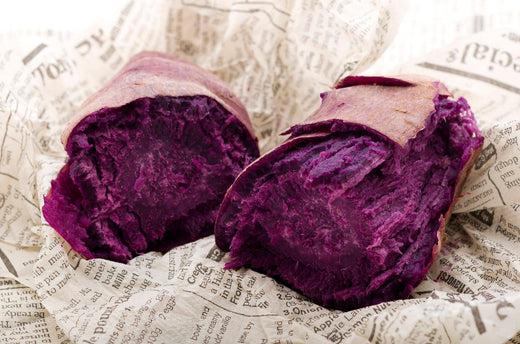
Jump to:
Most people with even a cursory knowledge of Japan will be able to tell you that rice is its staple food, so much so indeed that the commonly used Japanese words for breakfast, lunch, and dinner literally mean “Morning rice”, “Lunchtime rice”, and “Evening rice”. What may be less well known is that for most of its history, people on the southern island of Okinawa have enjoyed a different type of food as their main carbohydrate source. Beni Imo, a type of sweet potato, is considered by many to be a major factor behind the legendary longevity of the Okinawan people, offering a healthier alternative to rice.
In this post, we shall look at what the Beni Imo is, including its appearance and taste, the reasons behind its popularity in Okinawa, and its health benefits. We shall also compare it to similar vegetables, highlight some well-known dishes that include it, look at how to choose and store Beni Imo, and round off by looking at where to purchase Beni Imo and related products.
What Is A Beni Imo?

The Beni Imo is a purple sweet potato. Its skin is a creamy beige, but inside, it is colored a deep purple. The vibrancy of this color elevates any dish’s appearance. Its purple flesh is creamy and sweet, with hints of honey. The Beni Imo is not related to regular potatoes, which are members of the nightshade family, but rather is a member of the Morning Glory or yam family, similar to some other vegetables we think of as sweet potatoes.
History Behind The Popularity Of Beni Imo In Okinawa?
So how, when the rest of Japan became so reliant on rice as its staple food, did the Beni Imo come to flourish in Okinawa? To answer this question, it is instructive to look at both historical and geographical factors.
The history of the Beni Imo can be traced back to when Spanish explorers in the 1400s brought these tubers from the South and Central America and introduced them in China and the Philippines. Their captivating colors and distinctively sweet taste made them an instant hit within their newly adopted countries, and their influence on the cuisine of the respective nations can still be clearly seen today.
The Ryukyu Kingdom, as Okinawa was known at that time, had strong trading links with China, in fact, more so than with mainland Japan, and a Japanese government official trading with China in the early 1600s brought them back to Okinawa.
Unlike rice, which is difficult to grow in Okinawa, due to the storms that batter the island on a seasonal basis, Beni Imo thrived in the warm climate, and the fact that the Okinawan people were seen to thrive as a result of its nutritional density further increased its popularity, leading to it becoming the staple food in Okinawa.
Are Beni Imo Good For You?

The legendary longevity of the Okinawan people, which has started to wane in recent times due to the increasing influence of Western and mainstream modern Japanese dietary factors, led to it being labeled one of the so-called “blue zones”, or areas where people are expected to live longer and healthier lives (learn more about Okinawan cuisine here).
Although there are clearly other factors, such as its perennial warm climate, it can be argued that the widespread consumption of Beni Imo has also been an important factor in this. In fact, the decreased consumption of Beni Imo consumption in Okinawa tracks quite closely with the drop in the average lifespan (which, admittedly, is still high by anybody’s standards).
Its deep purple color results from the antioxidant anthocyanin, which is the same antioxidant found in blueberries, but present in even larger quantities in Beni Imo. They are also rich in B vitamins, potassium, and fiber, and are lower in calories than their equivalent weight in white rice. Studies have shown that they also contain antibacterial and antifungal properties and may help to reduce blood sugar.
The rest of the world is also waking up to their nutritional benefits, and Dr. Oz, on the Oprah Winfrey Show, included them in his list of the top five superfoods for 2010.
Beni Imo vs Satsuma Imo vs Murasaki Imo (Japanese Purple Sweet Potatoes)

Beni Imo, Satsuma Imo, and Murasaki Imo are often lumped together as purple sweet potatoes but there are important differences between the three of them.
Satsuma Imo have darker purple skin with yellow flesh. These are the sweet potatoes famously baked and sold from trucks on the streets of Japan as Yaki-Imo. Their flesh is incredibly sweet and more starchy than other sweet potatoes. It is a member of the sweet potato family.
Beni Imo, on the other hand, have a lighter skin and bright purple interior. They are slightly less sweet than Satsuma Imo, but have a similar starchy quality. Unlike Satsuma Imo, however, Beni Imo are actually a member of the yam family, so despite similarities in appearance and taste and commonly referred to as a sweet potato, they are scientifically speaking very different. You can learn more about Satsuma Imo here.
Murasaki Imo tends to be the least sweet of the three types of potato discussed here. Despite having purple flesh like the Beni Imo, it is, in fact, a member of the sweet potato family.
How Are Beni Imo Eaten?

Although because of its sweet taste, it has made its way into many dessert-type dishes, such as Beni Imo Tart, it is still most popularly enjoyed as a healthy side dish with rice. One popular way to eat it is to steam it until tender and add green onion and sesame oil.
They are also delicious when roasted in the oven as the heat caramelizes their natural sugars. You might also like to try them when boiled and mashed with miso, and nori seaweed sheets placed on top.
The important thing is that because Beni Imo have such a delicious natural sweetness, you will not need to add any strong flavors to it when preparing it. It is most easily enjoyed in its simplest form.
Around the world, Beni Imo are very popular in Hawaii, and Haupia Pie is a delicious pie dish with mashed Beni Imo adding the purple layer between the pie crust and the cream.
Buying, Choosing, and Storing Beni Imo
You can find Beni Imo in most supermarkets in Okinawa, but it is very difficult to find them outside of Okinawa. In Okinawa, and other southern islands, there is an infestation of potato weevils, which cause significant damage to the crops. As a result, taking Beni Imo outside of Okinawa is prohibited unless they are steam-heated. The steam-heat treatment is performed at a low temperature of 47-48 degrees Celsius, so the potatoes remain raw. If you go to Okinawan eateries outside of Okinawa, they will use steam-heated Beni Imo.
When choosing Beni Imo, the important thing to look for is that they are firm to the touch, do not have any sprouts on them, and are free of any wrinkled skin or brown spots. As long as these points are satisfied, you are not likely to go too far wrong.
Storing them, however, is a little bit trickier. They tend not to be as robust as other potatoes and should be handled carefully otherwise they can bruise easily. If stored in the refrigerator, the inside can get very hard, so it is better to store them at room temperature, where they can last for a week or more. If you can find a cool, dark, well-ventilated place to keep them, they will last for even longer.
Ways To Enjoy Beni Imo
As stated earlier, it is difficult to find raw Beni Imo, but you can enjoy steam-heated Beni Imo at any of the numerous Okinawan restaurants and Izakaya in other parts of the country. Another way for you to enjoy Beni Imo is to eat it in processed form.
The subtle sweetness of Beni Imo makes it a favorite filling for a range of snacks and desserts. You can find Beni Imo tart on the Japanese Taste website, where you can also find a wide range of healthy snacks.
Beni Imo- The Purple Okinawan Superfood

Introduced through its trading ties with China during the time of the Ryukyu kingdom, the Beni Imo has long been the staple carbohydrate source in Okinawa and its superior nutritional qualities compared to rice have led to it being dubbed a superfood throughout the world and have undoubtedly contributed to the impressive longevity of its citizens.
Although Okinawans have also fallen prey to the modern-day trappings of fast food, as well as embracing rice, the staple food of the mainland, the Beni Imo forms the basis for many famous Okinawan dishes and is exported outside of Okinawa in the form of snacks and sweets.
Have you tried Beni Imo? Let us know your impressions of it in the comments.


0 comments